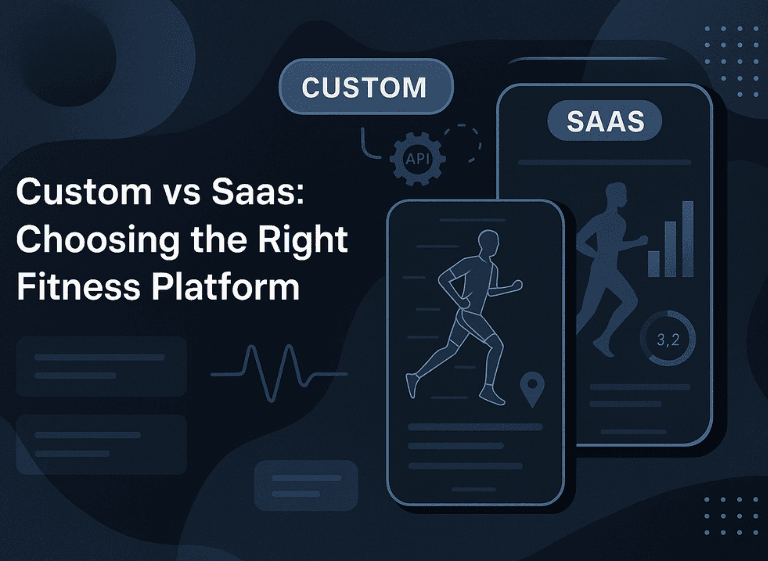MVP development
Mobile app development
Product strategy
UI/UX Design
Real project examples
Custom vs SaaS: Choosing the Right Fitness Platform
Nadiia Sidenko
2025-05-19
Facing the build vs buy fitness platform dilemma? You’re not alone. Whether you're evaluating a custom fitness platform to match your business goals or considering SaaS fitness software for faster deployment, the decision is critical. At a key growth point, many fitness businesses find themselves at a technological crossroads—torn between costly custom development challenges and the limitations of one-size-fits-all SaaS solutions. This choice doesn’t just affect your current budget—it shapes your scalability, security, and brand control for years to come. Based on our experience with fitness clients navigating this decision, we've seen how the right platform unlocks growth—and the wrong one limits it.

Custom Fitness App vs SaaS: What's the Difference for Your Business?
When evaluating fitness software solutions, the distinction between custom and off-the-shelf options extends far beyond surface-level features. Let's examine the core attributes of each approach to illuminate their strategic implications.
What is a Custom Fitness Platform?
A custom fitness platform is a bespoke digital solution built specifically for your business requirements, user experience needs, and operational workflow. Unlike standardized options, custom development begins with a thorough discovery process that translates your unique value proposition into technical specifications. This approach creates a tangible MVP that evolves precisely according to your market feedback and business objectives.
For instance, platforms like RunSafe demonstrate how custom development enables fitness businesses to implement proprietary training methodologies, specialized data metrics, and branded user experiences that would be impossible within the constraints of standardized software.
What is a SaaS Fitness Platform?
SaaS (Software as a Service) fitness platforms offer pre-built solutions that fitness businesses can subscribe to and deploy quickly. These platforms typically provide standardized features designed to meet common industry needs—workout tracking, membership management, scheduling, and basic analytics—without the upfront development investment. The appeal lies in rapid implementation and predictable subscription pricing, making them attractive for businesses prioritizing speed-to-market over differentiation.
However, this convenience comes with significant constraints when you reach growth stages requiring more sophisticated functionality. Success starts with an MVP that can adapt to evolving market demands—a flexibility that SaaS solutions often lack once you exceed their standard feature set.
Choosing between SaaS and custom fitness platforms often feels like comparing speed to strength. While SaaS solutions promise quick launches, they rarely offer the flexibility, integration depth, or brand ownership needed for long-term differentiation. The table below outlines how each model supports — or limits — your fitness business at various stages of growth.
Custom vs SaaS: Which Fitness Platform Model Supports Long-Term Growth?
| Key Factor | Custom Fitness Platform | SaaS Fitness Platform |
|---|---|---|
| Time to Market | Strategic setup aligned with business goals | Immediate deployment with predefined workflows |
| Feature Flexibility | Tailored functionality built around your unique value proposition | Standard features with limited adaptability |
| Brand Experience | Fully branded UX tailored for your users | Generic interface shared across multiple businesses |
| Data Control & Security | Full control, regional compliance, advanced encryption | Vendor-governed, standardized protocols |
| Integration Options | Custom APIs, full backend flexibility | Limited to vendor-supported tools |
| Scalability | Built to support complex growth and future expansion | May require replacement once scaling limits are reached |
| Strategic ROI | Higher initial investment with greater long-term value and differentiation | Lower entry cost, but reduced competitive positioning over time |
Flexibility and Scalability: How Custom Apps Adapt to Unique Business Models
As your fitness business expands, the limitations of standardized software become increasingly apparent, especially when attempting to implement innovative features or adapt to emerging market opportunities.
Limitations of SaaS in Growth-Stage Companies
SaaS platforms impose inherent constraints on growing fitness businesses:
– Feature requests must align with the provider's roadmap and broader customer base
– Integration capabilities typically restricted to mainstream partners and APIs
– Customization often limited to visual elements and basic configuration
– Scaling costs follow the provider's pricing model rather than your actual usage needs
Much like the situation in e-commerce where platforms eventually restrict growth, fitness SaaS solutions create similar bottlenecks. Just as businesses outgrow standardized stores, fitness companies eventually hit functionality ceilings, as explored in our analysis of top 5 e-commerce platforms and their scalability constraints.
Why Custom Platforms Scale Better
Custom fitness software offers superior scalability for several fundamental reasons:
- Architecture Control: Backend systems designed specifically for your peak loads and processing requirements
- Priority-Based Enhancements: Development roadmap determined by your business objectives, not external priorities
- Flexible Infrastructure: Ability to optimize costs by scaling specific components independently
- Adaptation Speed: Direct implementation of market feedback without waiting for SaaS update cycles
The RunSafe case demonstrates how a custom approach enables fitness platforms to evolve in response to actual user engagement and emerging business opportunities. This adaptability creates a significant competitive advantage compared to competitors constrained by SaaS limitations, echoing principles discussed in how MVPs boost startup growth.
Data Control and Security: What SaaS Can't Guarantee
In the fitness sector, data represents both a strategic asset and a significant responsibility. Custom development provides fundamental advantages in this critical area.
Why Custom Apps Offer Better Protection
With custom fitness app development, your business gains comprehensive control over:
– Data storage locations and jurisdictional compliance
– Encryption implementation and security protocols
– Access control mechanisms and authentication systems
– Backup procedures and disaster recovery processes
These capabilities prove especially valuable when managing sensitive health information and payment details. Custom development enables implementation of key security practices for app development tailored specifically to fitness industry requirements and regional regulations, providing granular control over data storage, encryption, and access that is paramount in meeting evolving privacy regulations through robust data governance strategies.
Backend Architecture and Integration Capabilities
The backend architecture of your fitness platform determines not just security but integration flexibility with crucial business systems:
– Wearable device connections and real-time data processing
– Payment processing and subscription management
– Health records and compliance systems
– Marketing automation and engagement tools
Custom development enables creation of purpose-built APIs and seamless third-party integrations that would be impossible with standardized SaaS architecture. This extensibility becomes increasingly valuable as your fitness ecosystem grows, as seen in our insights on backend development for business mobile apps.
UX and Retention: Designing Fitness Apps Users Stick With
In the competitive fitness app landscape, user retention ultimately determines success. Custom development offers decisive advantages in creating engaging experiences that minimize churn.
Custom UX Drives Higher Engagement
Standard SaaS interfaces inevitably reflect design compromises made to accommodate diverse customers. In contrast, custom fitness platforms enable:
– Interface designs that perfectly embody your brand identity
– User flows optimized for your specific audience behaviors
– Interaction patterns aligned with your unique service model
– Personalization capabilities that increase emotional connection
These UX advantages translate directly to business outcomes through UI/UX design for business growth, creating differentiated experiences impossible with template-based approaches. For fitness applications specifically, implementing mobile-first UX for small screens proves essential for capturing the primarily smartphone-based fitness audience.
Advanced custom platforms can also implement leveraging AI for UX research to continually refine user experiences based on actual interaction patterns—a capability typically beyond SaaS constraints.
The Custom Development Journey: From Discovery to Market Launch
Implementing a custom fitness platform involves a structured process that transforms your business vision into a market-ready solution.
The Value of a Full-Cycle Development Partner
Selecting the right development partner significantly impacts both your platform's quality and your overall experience. Consider these essential factors:
– Domain expertise in fitness technology and user behavior
– Technical proficiency across required technologies
– Transparent project management and communication systems
– Alignment with your business values and work culture
These considerations mirror those in our comprehensive guide to choosing a web development partner, though with specific emphasis on fitness industry experience.
Tech Stack Choices That Fit Fitness Needs
The technological foundation of your fitness platform determines its performance, scalability, and maintenance requirements. Critical decisions include:
– Native vs. cross-platform development approaches
– Real-time data processing capabilities
– Cloud infrastructure selection and configuration
– API architecture and integration framework
For fitness applications with cross-device requirements, evaluating Flutter vs React Native frameworks becomes particularly relevant when balancing development efficiency against performance requirements.
Investment and ROI: Custom vs SaaS in the Long Run
While SaaS solutions typically offer lower initial costs, comprehensive financial analysis reveals a more complex picture over extended timeframes.
How to Calculate True Value
Accurate ROI assessment requires examining both direct and indirect factors:
Direct Costs:
– Development/subscription expenses
– Ongoing maintenance and enhancement
– Infrastructure and operational overhead
– Integration and customization requirements
Indirect Value:
– User retention improvements
– Operational efficiency gains
– Competitive differentiation benefits
– Data ownership and monetization potential
This multi-dimensional approach mirrors principles outlined in success starts with an MVP, emphasizing that initial investment must be evaluated against long-term business impact.
Real Outcomes From Tailored Platforms
Custom fitness platforms consistently demonstrate superior ROI when measured across complete business cycles. The RunSafe case illustrates how bespoke development enables:
– Proprietary features that create defensible market positions
– Optimized conversion funnels aligned with specific audience behaviors
– Reduced customer acquisition costs through superior retention
– Progressive enhancement based on actual usage patterns
These outcomes typically surpass what's possible with standardized solutions, particularly for businesses with distinctive methodologies or specialized target segments.
Final Decision Checklist: Which Path Fits Your Fitness Vision?
Making the optimal choice between custom and SaaS requires systematic evaluation of your specific business context.
Consider Team, Timeline, Budget, and Target Users
Evaluate these critical factors when determining your approach:
– Team Capabilities: Internal technical resources and domain expertise
– Market Timing: Competitive landscape and first-mover advantages
– Investment Capacity: Both immediate and ongoing financial resources
– Differentiation Requirements: How central unique features are to your value proposition
– Growth Trajectory: Anticipated scaling needs and expansion plans
This structured decision process aligns with principles detailed in our guide to MVP in software development, emphasizing alignment between technical decisions and business strategy.

Making Your Decision
The choice between custom and SaaS for your fitness platform ultimately depends on your strategic priorities—whether standardization and speed outweigh differentiation and control in your specific market context. However, businesses with ambitious growth objectives and distinctive methodologies typically find custom development offers significant long-term advantages despite higher initial investment.
Rather than navigating this complex decision alone, partnering with experienced developers who understand the fitness industry's unique challenges ensures your technology strategy aligns with your business vision. The right development partner brings not just technical expertise but strategic insights that transform your fitness concept into a compelling digital reality that stands apart in an increasingly crowded marketplace.